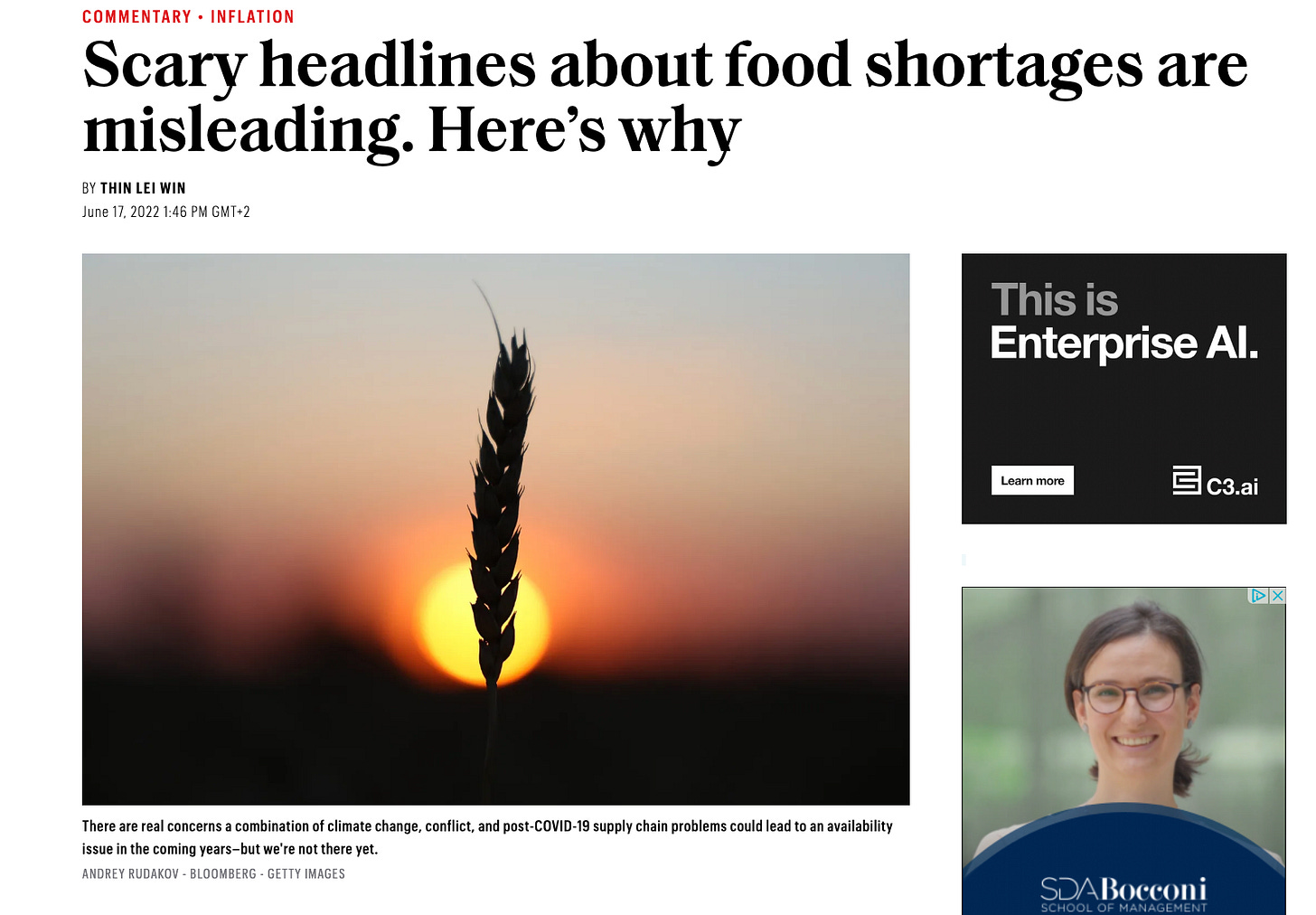It’s All About ME!
Don't say I didn't warn you...
I’m serious. Although it isn’t intentional, most of this newsletter is about me. 😬
A new look
Yes, if you’re wondering, I’ve got a new look, which I think is lovely, thanks to the Substack Food Fellowship I’ve been on.
A specific shoutout to Brandon Webber who came up with a new logo, a proper e-mail banner, a new welcome page and all sorts of nice-looking things, including some that are inspired by my Burmese heritage.
Misleading headlines
Here’s a commentary I wrote for Fortune on my current favourite topic - why headlines about food shortages are misleading.
It’s pretty similar to what I wrote in this publication a few weeks ago but a bit more structured and makes three key points:
These stories conflate access and affordability with availability
The export figures only tell 24.7% of the story
The focus on Ukraine obscures structural problems in our food system
I’m sorry to keep banging on about this. I just think it’s so important to see the nuances and not make things worse by panicking over the wrong things.
Ukraine War and The Food Price Crisis
In the latest episode of the Farm Gate, a podcast about regenerative agriculture which focuses on practical solutions for climate and food security, I became an interviewee instead of the interviewer.
The Jun 14 episode was all about the food price crisis we are currently in and “while Russia lit the touch paper, this crisis was predicted and could have been avoided”.
I joined host ffinlo Costain, Professor Jennifer Clapp, an expert for Brussels-based IPES-Food and the Canada Research Chair in Global Food Security and Sustainability at the University of Waterloo in Ontario, and Margot Gibbs, my partner-in-crime for the Hunger Profiteers investigation.
Margot and I spoke about our investigation but Jennifer gave a broad overview of all things that are wrong with our food systems.
I always learn so much from listening to her so take a break from surfing the Internet for 38 minutes to listen to this.
Beyond Ukraine: The Untold Story of the Food Crisis.
A Growing Culture and The International Panel of Experts on Sustainable Food Systems (IPES-Food) are organising a workshop for journalists on Jun 23, 2022 covering things I’ve just vented about in the previous two sections.
Some very cool experts from IPES-Food will be there as will yours truly giving her two cents’ worth. But you know what I’ll be saying so tune in to hear the veterans, which includes Ricardo Salvador from Union of Concerned Scientists and Sofía Monsalve Suárez from FIAN International.
Announcement below and registration link here.
Some Non-Me News
$1.8 trillion
That’s the global food import bill this year, and it’s a new record, up nearly 3% from last year. The bill for 2021 was already an all-time-high, jumping almost 18% from 2020.
Just to put it in context, this is what $1.8 trillion looks like with all the zeros - $1,800,000,000,000.
Much of the increase this year is a result of higher prices and transport costs and not because countries are importing more, said the Food Outlook, a twice-yearly publication from the UN food agency, the Food and Agriculture Organization (FAO).
“The anticipated increase in the 2022 import bill is almost entirely on account of higher prices: $49 billion are due to higher international prices and merely $2 billion reflect higher volumes.”
In fact, many poor and vulnerable countries are going to get less despite paying more, the report said. In fact, developing nations are already reducing the amount of cereals, oilseeds and meat they import, but will see an increase in total costs.
For example, Sub-Saharan African countries are expected to spend $1.5 billion more and food imports but will see a decline in volumes worth $0.9 billion. In Net Food-Importing Developing Countries, the bill is gonna be $1.3 billion higher for $2.2 billion less in volumes.
Meanwhile, least developed countries are going to slash their food import bill by $2.4 billion because they are simply going to bring in much less food.
“These are alarming signs from a food security perspective,” the report said.
“While developed countries continue purchasing across the entire spectrum of food products, the budgets of developing regions will be increasingly concentrated on importing staple foods, with shrinking inflows of high value products such as meat, beverages and oilseeds.”
The above point also raises concerns about diet quality and diversity and how this will affect long-term nutritional status.
When solution journalism goes too far?
Interesting thread from a climate correspondent in Delhi about the dangers of thinking “Solution Journalism” is the only option to cover complex and nuanced issues like climate change.
An agri roadmap for slashing emissions?
FAIRR, an investor network said to be managing $14 trillion in assets, has sent a letter to the FAO urging it to “produce a global roadmap to 2050” that will help to reduce the massive amounts of greenhouse gases emitted by agriculture.
No such plan clear exists currently despite our food systems’ critical role as both contributor and victim of climate change, and experts have said the world’s efforts to limit global warming will not be successful without tackling agriculture.
Here’s the letter and here’s a Reuters story on it.
As always, have a great weekend! Please feel free to share this post and send tips and thoughts on twitter @thinink, to my LinkedIn page or via e-mail thin@thin-ink.net.








